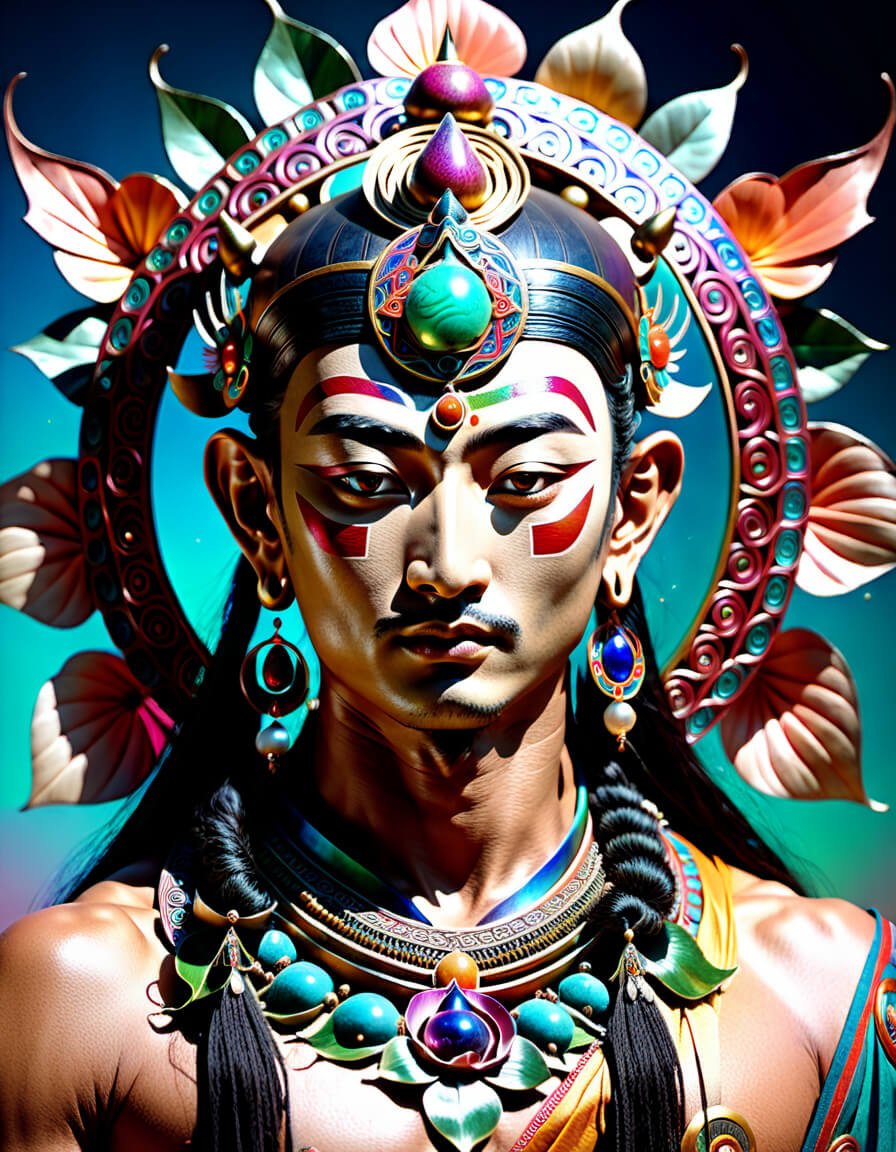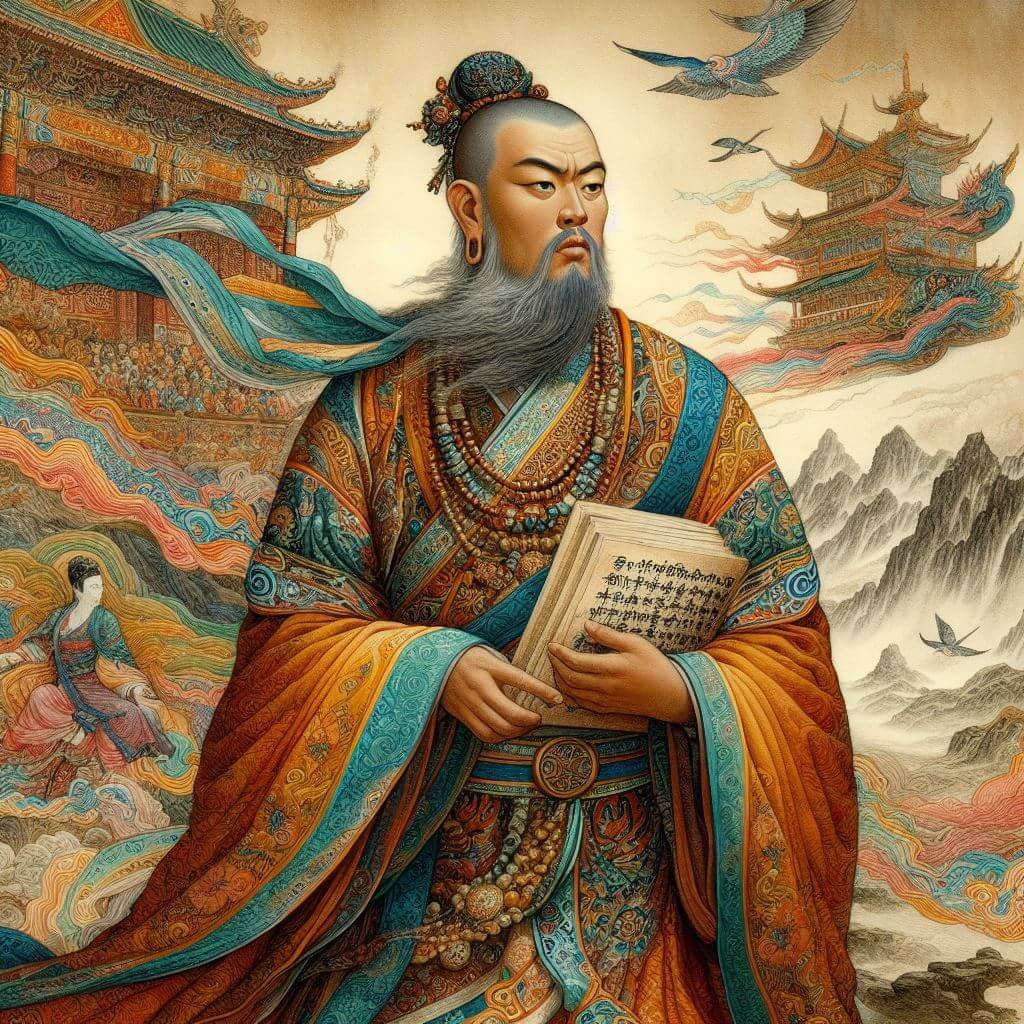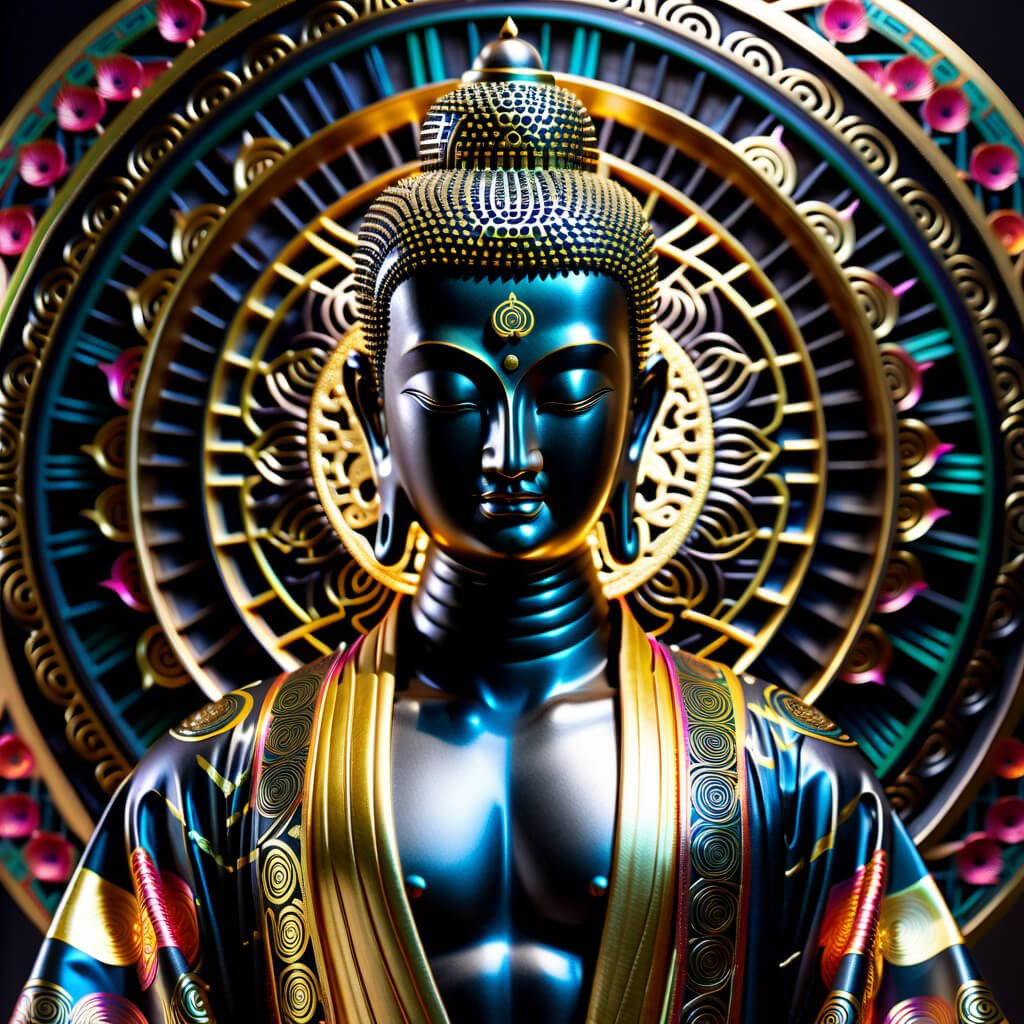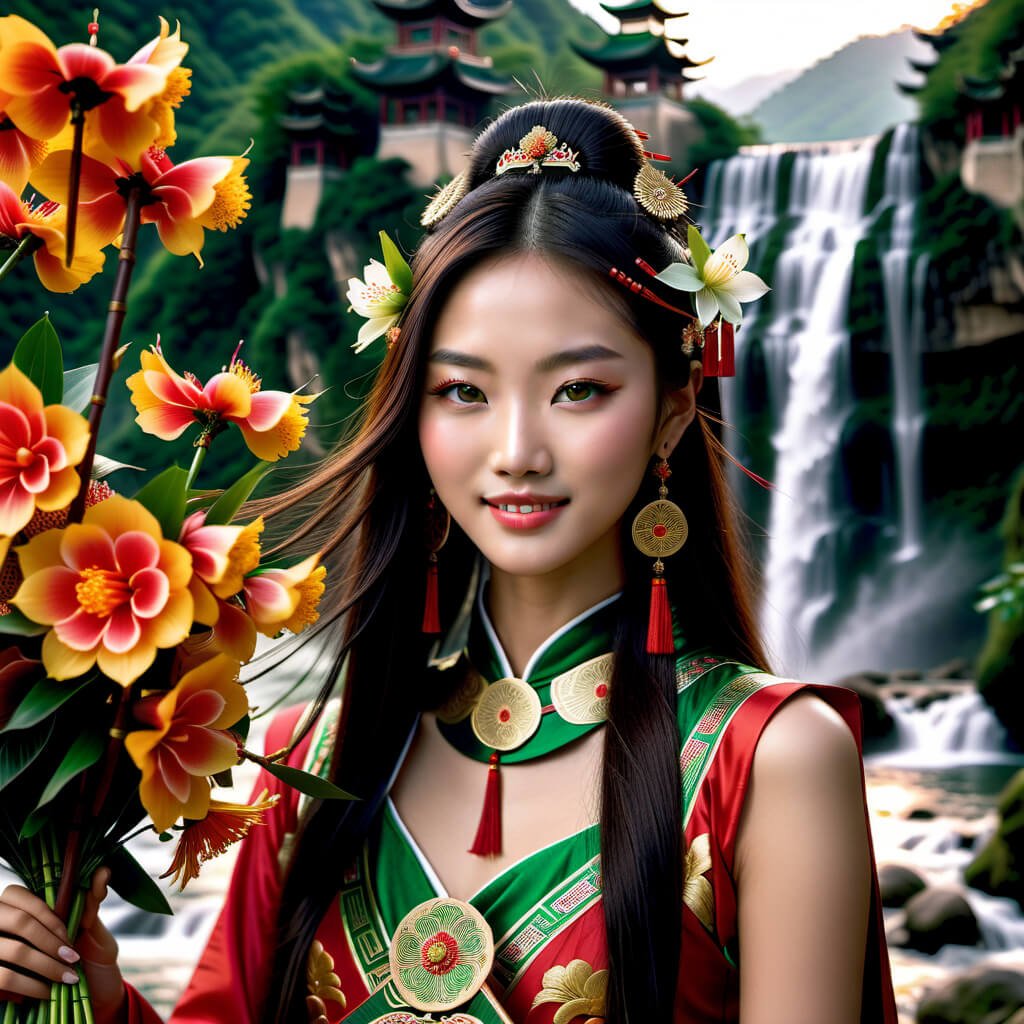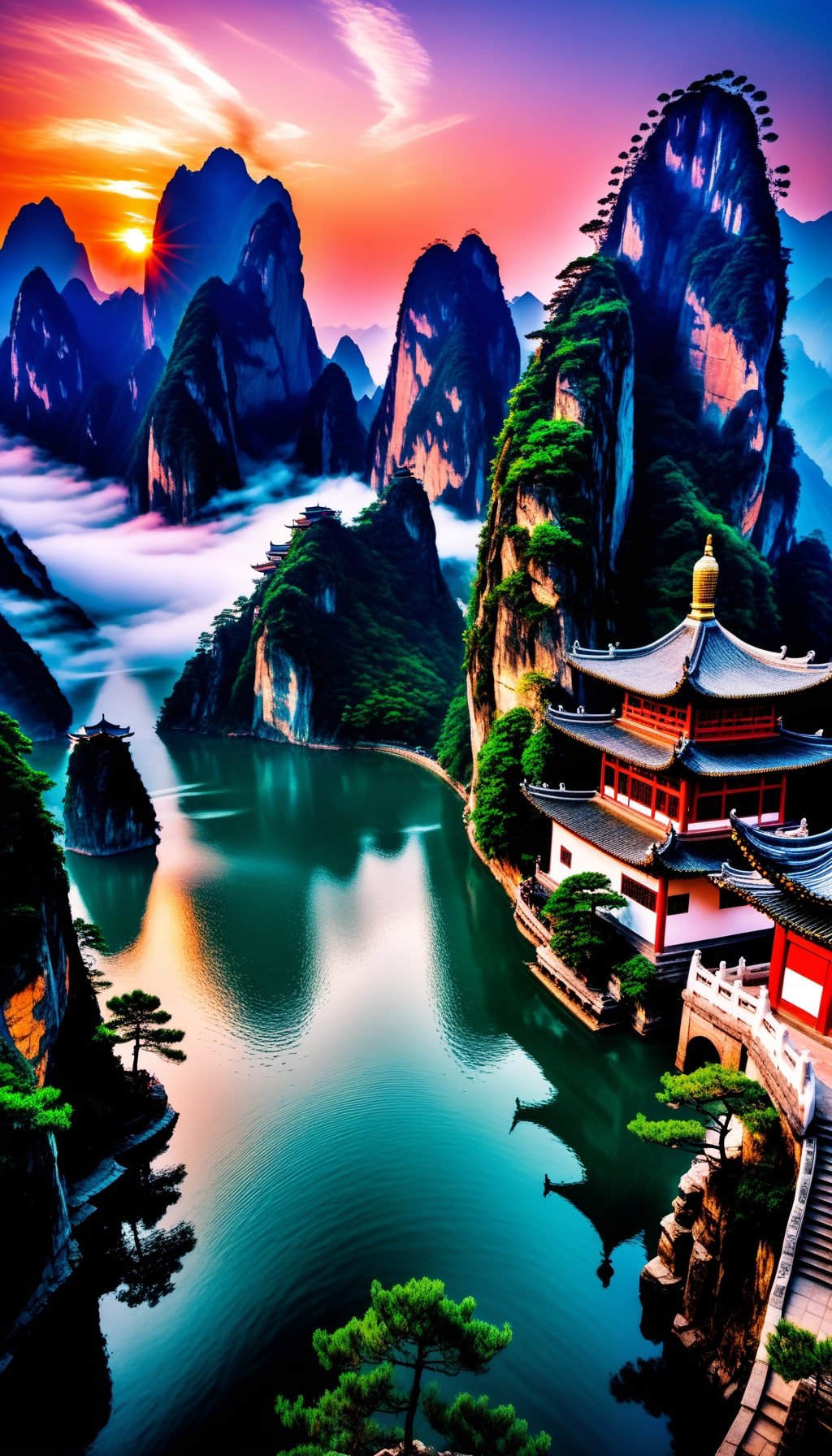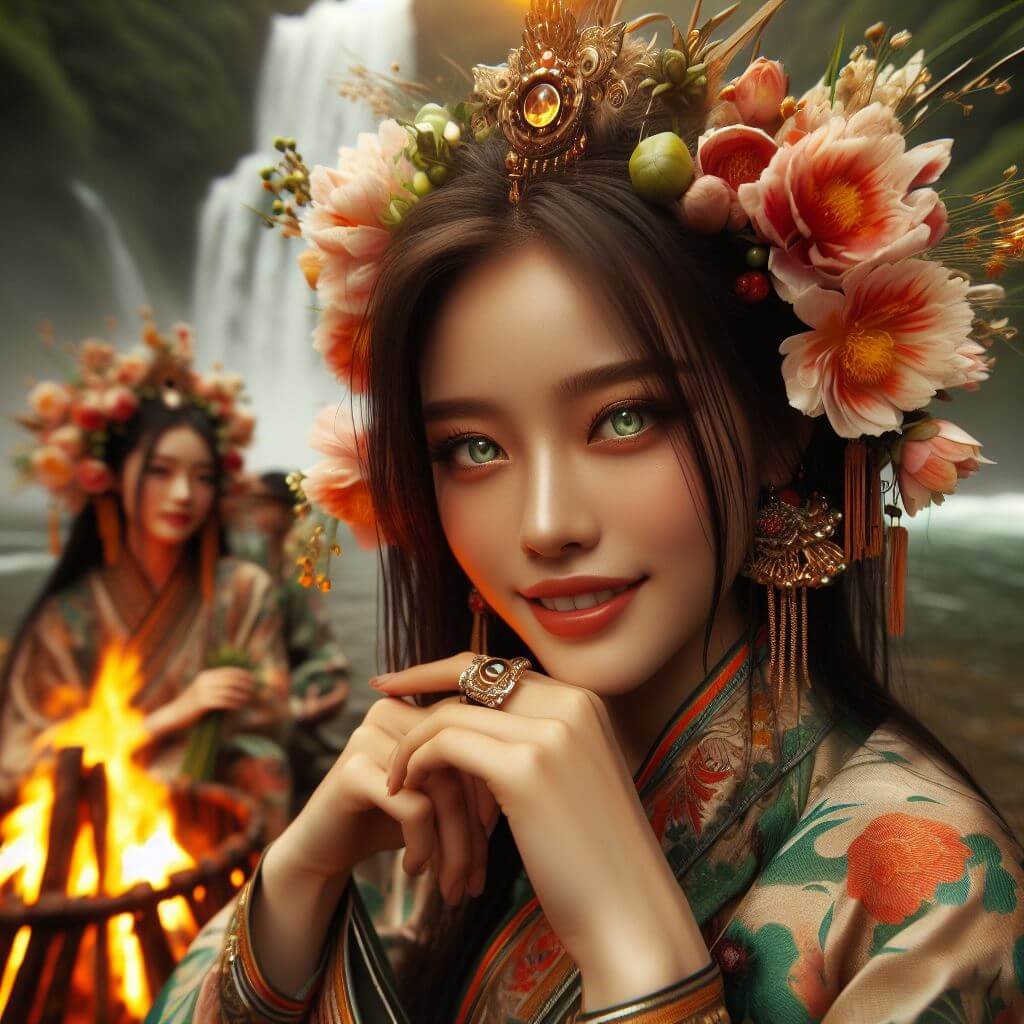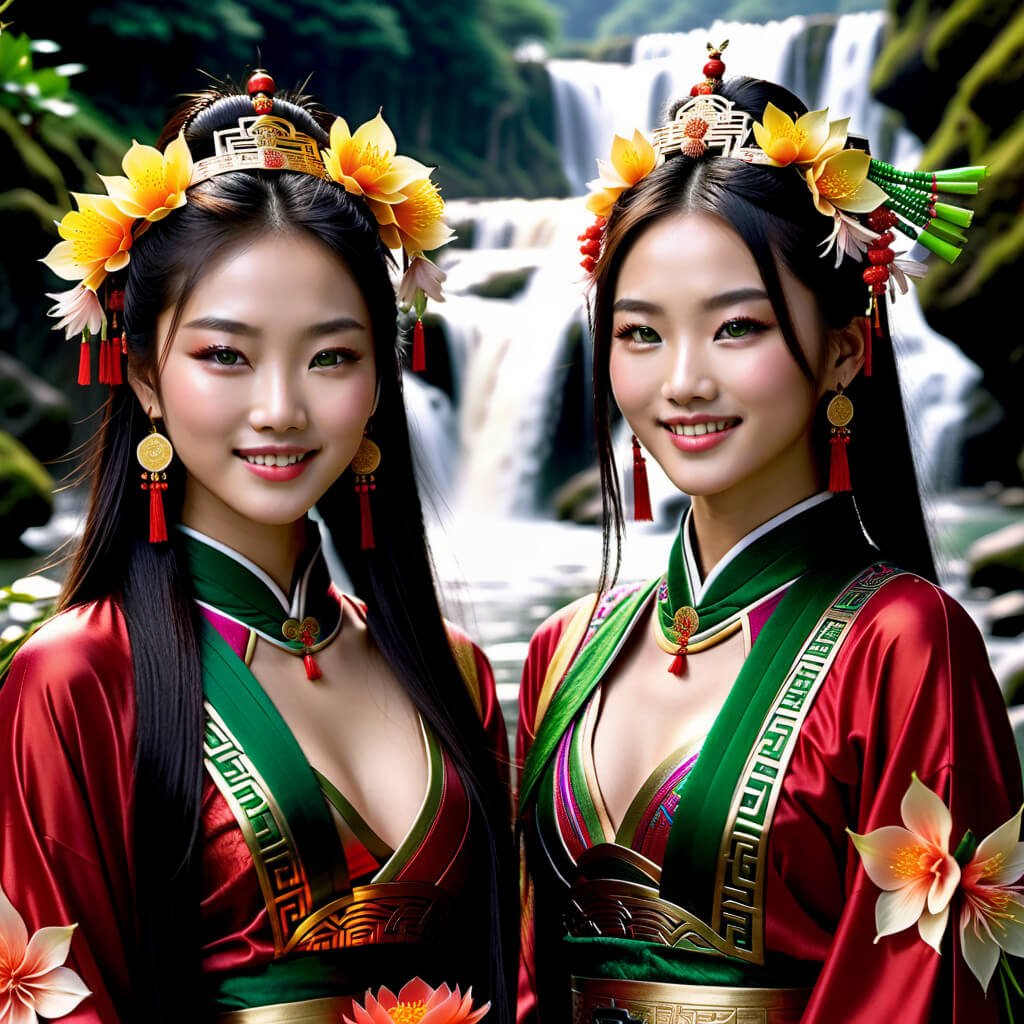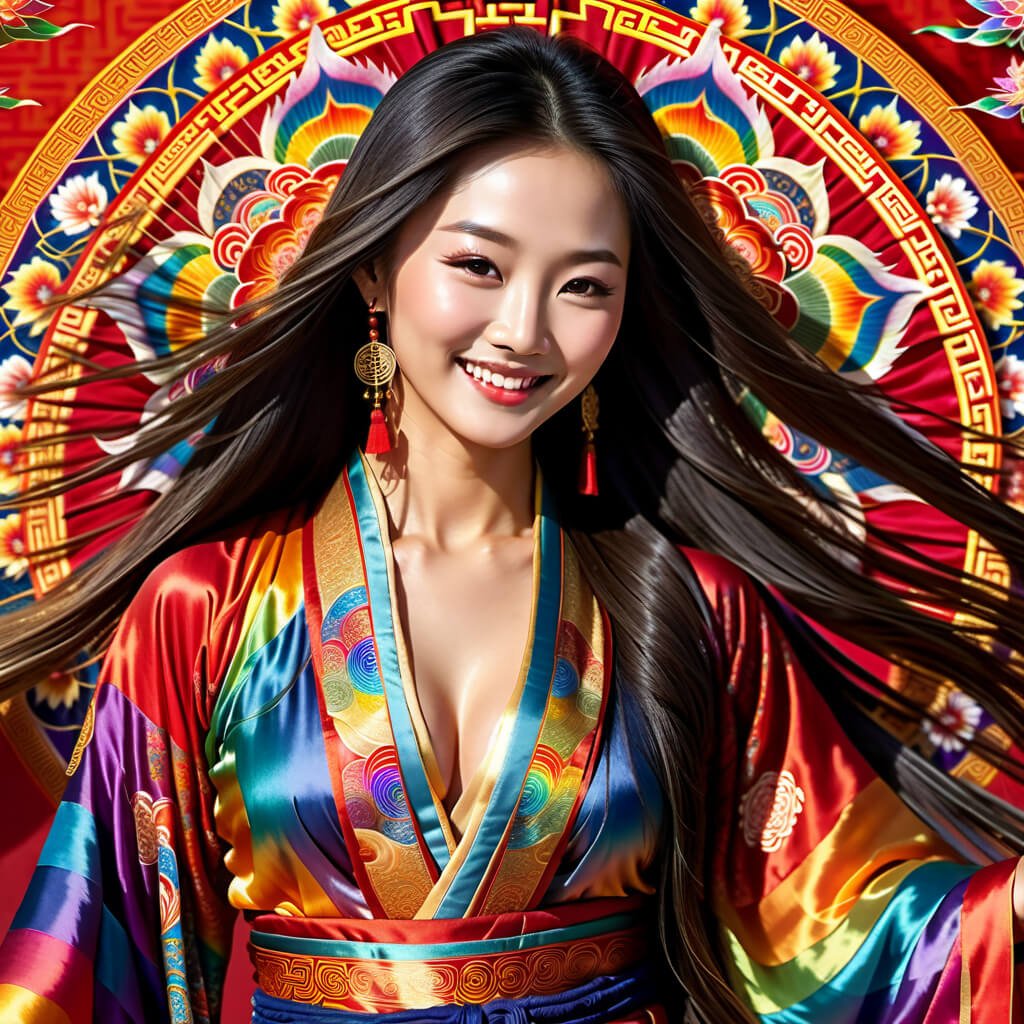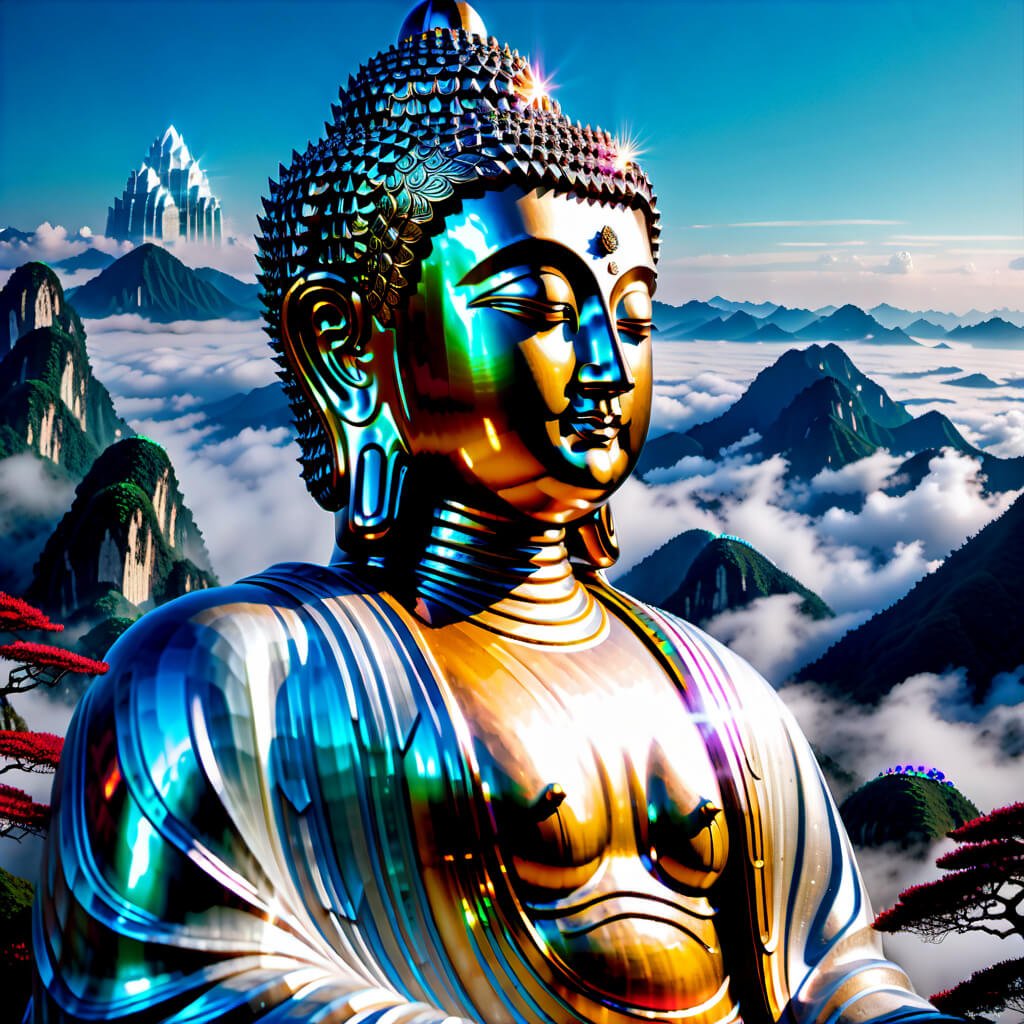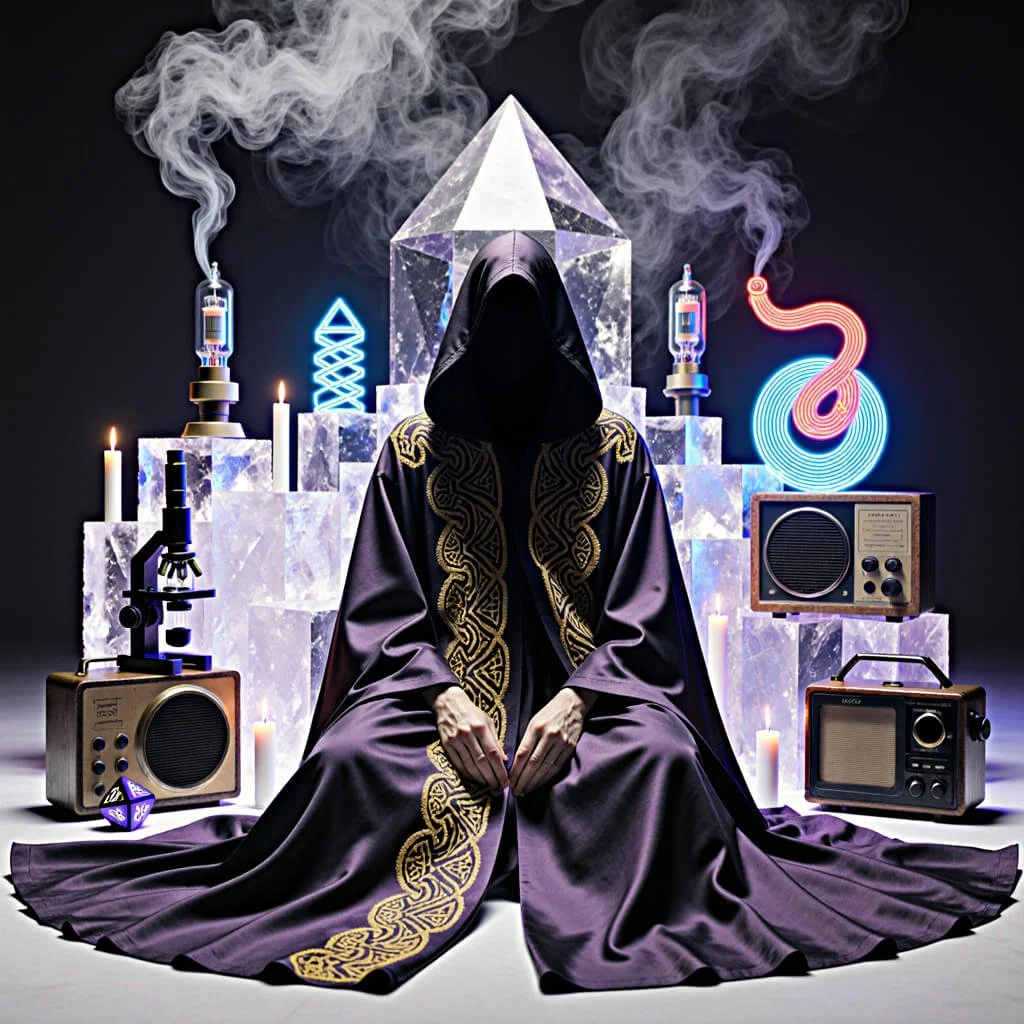Sacred Geography and the Evolution of Buddhism in China
Sacred Geography of Esoteric Buddhism: Nature & The Enlightened Mind in China
Key Takeaways:
Buddhism's transmission to China catalyzed a profound synergy between Indian spiritual traditions and indigenous Chinese philosophies, birthing unique syncretic practices and artistic expressions.
Sacred sites like Mount Fanjing and the Mogao Caves exemplify the intricate interweaving of Buddhist symbolism, geomancy, and esoteric arts within Chinese culture.
Esoteric Buddhist traditions, such as the Zhenyan school, incorporated ritual magic, divination, and mystical attainments, blending with China's rich occult heritage.
The merging of Buddhist iconography, sacred geometries, and Chinese visual arts gave rise to a rich tapestry of symbolic and metaphysical expression across architecture, murals, and sculpture.
Contemporary revivals of esoteric Buddhism in China and its global influence underscore the enduring relevance of these mystical traditions in exploring the boundaries of consciousness and spiritual embodiment.
Sacred Geography and Evolution of Buddhism in China, Golden Flame of the Eternal Buddha-Mind, Surreal Esoteric Portrait
The ancient landscapes of China are suffused with an ineffable spiritual resonance, echoing the harmonious interplay between the natural world and the esoteric realms of enlightened consciousness. It is within this mystic confluence that the story of Buddhism's transformative journey through the Middle Kingdom unfolds, leaving an indelible imprint upon the land, culture, and spiritual fabric of Chinese civilization.
From the soaring peaks of sacred mountains like Fanjing and Wutai to the awe-inspiring Buddhist cave sanctuaries at Dunhuang and Yungang, a rich tapestry of symbolism and sacred geography emerges. These hallowed sites, etched into the very bones of the earth, stand as living talismans - repositories of ancient wisdom, gateways to transcendent realms, and enduring testaments to the profound synergy between Buddhist thought and Chinese philosophies.
Within the boundaries of these consecrated spaces, a cosmic dance unfolds, one in which the esoteric symbolism of Buddhism intertwines with the indigenous spiritual traditions of Daoism, Confucianism, and folk shamanism. Sacred geometries, archetypal iconographies, and the potent resonances of mantras and mudras coalesce, birthing syncretic traditions that channel the raw creative force of enlightened awareness itself.
Mystical Ambience on a Sacred Pilgrimage at Mount Wutai
It is this alchemical merging of horizons that allows Buddhism to leave such an indelible mark upon China, its influence radiating outward from sacred epicenters to infuse every aspect of art, architecture, philosophy, and spiritual praxis. From the mystical attainments of esoteric lineages to the symbolic metaphysics woven into the very fabric of temple design, Dharma's transmission across the Middle Kingdom stands as a testament to the enduring power of the human spirit to transcend boundaries and unlock the infinite potential of consciousness.
In the pages that follow, we embark upon an experiential exploration of this multifaceted legacy, delving into the mystic heart of Buddhism's sacred geography in China.
Majestic Mount Fanjing: Sacred Heart of Esoteric Buddhism in China
Mount Fanjing: A Sanctum of Enlightenment
Nestled in the southeastern province of Guizhou, Mount Fanjing rises majestically, its craggy peaks piercing the heavens and its slopes cloaked in verdant forests. It is here, at an altitude of 2,570 meters above sea level, that two ancient Buddhist temples cling precariously to the summit, their very existence a testament to the indomitable spirit of the faithful. These structures, perched atop towering rock pinnacles and connected by a narrow bridge that spans a treacherous gorge, are known as the Fanjing Temples.
The origins of these sacred edifices are shrouded in the mists of time, but historical records indicate that Buddhism first took root in the region during the Tang Dynasty, in 639 CE (Xie et al., 2021). The temples were likely constructed sometime after this initial introduction, though their precise date of construction remains a subject of scholarly debate. What is known, however, is that they were rebuilt approximately 500 years ago, their current forms are a testament to the enduring reverence for the Buddhist teachings they enshrine.
The temples themselves are a study in contrasts, their austere exteriors belying the rich tapestry of symbolism and spiritual significance that lies within. One, perched atop the New Golden Summit or Red Cloud Golden Summit, is a 100-meter-tall column of rock that rises defiantly from the ridge of Mount Fanjingshan. The other, its architectural counterpart, sits opposite, the two structures united by the slender bridge that spans the chasm between them (Wang & Xu, 2019). It is this bridge, a mere thread against the vastness of the landscape, that serves as a potent metaphor for the Buddhist concept of the Middle Way, the path of moderation and balance that lies between the extremes of sensual indulgence and severe asceticism.
Golden Monkey Sits in Deep Meditation Atop Mount Fanjing, 24K Gold Hyperdimensional Sculpture
Symbolism and Sacred Landscapes
The symbolism inherent in the Fanjing Temples is not limited to their physical structures alone; rather, it extends outward, imbuing the very landscape itself with a rich tapestry of meaning. Mount Fanjing itself is considered a bodhimaṇḍa, a sacred site believed to be the future locus of enlightenment for the Maitreya Buddha, the embodiment of loving-kindness who will succeed the historical Buddha, Siddhartha Gautama (Hua, 2018). This association with the Maitreya lends the mountain a profound spiritual significance, drawing pilgrims and devotees from far and wide to bask in its hallowed aura.
The natural features of Mount Fanjing further reinforce its sacred character, with countless rock formations, waterfalls, and geological wonders taking on symbolic associations within the context of Buddhist thought. The Red Cloud Golden Summit, upon which one of the Fanjing Temples rests, is said to resemble a seated Buddha, its silhouette a constant reminder of the path to enlightenment (Li et al., 2020). Elsewhere, the mountain's numerous caves and grottoes have been transformed into sanctuaries for meditation and contemplation, their cool, dimly lit interiors providing a refuge from the distractions of the material world.
Rainbow Transmission of the Vajrayana Mysteries from India to Tibet and On to China, Surreal Esoteric Portrait of the Tantric Rainbow Buddha
Buddhist Creativity in Motion
Beyond the physical realm, the esoteric arts and creative culture associated with Buddhism have left an indelible mark on the spiritual landscape of China. Across the country, countless works of art, from intricate sculptures and paintings to elaborate dance and music performances, bear witness to the profound influence of Buddhist thought on the Chinese artistic tradition (Cao, 2021). These creative expressions, often imbued with symbolic meaning and spiritual significance, serve as potent reminders of the enduring relevance of Buddhist teachings in the modern world.
The Fanjing Temples, with their precarious perch atop the sacred mountain and their rich tapestry of symbolism, stand as a powerful embodiment of this interplay between the natural and the spiritual, the physical and the metaphysical. They are a testament to the enduring resilience of the Buddhist faith in China, a faith that has weathered the storms of history and emerged as a vibrant and vital force in the cultural and spiritual fabric of the nation.
Sacred Geography of Mystical China, Mountaintops of Reverence, Steps of Awakening Compassion
The Evolution of Buddhism in China
To fully appreciate the significance of sites like Mount Fanjing and the Fanjing Temples, it is necessary to trace the historical trajectory of Buddhism in China, a journey that spans centuries and encompasses a rich tapestry of cultural exchange, adaptation, and synthesis.
The earliest recorded instances of Buddhism in China date back to the Han Dynasty, during the 1st century CE, when Buddhist texts and teachings first began to trickle into the country from India and Central Asia (Yu, 2020). These early encounters, facilitated by the network of trade routes collectively known as the Silk Road, laid the foundations for what would become a profound and lasting impact on Chinese culture and society.
Master of the Vajra Secret, Esoteric Portrait of Vajrapani inspired by Tibetan Buddhism
The Tripartite System Emerges
As Buddhism took root in China, it underwent a process of adaptation and syncretization, blending with existing philosophical and religious traditions to create a unique and distinctly Chinese expression of the faith. The concepts of Buddhism, with their emphasis on non-violence, compassion, and the impermanence of material existence, found resonance with the precepts of Daoism and Confucianism, two pillars of Chinese thought (Zhuang, 2021). This convergence of belief systems gave rise to a syncretic tradition that seamlessly integrated Buddhist teachings with the cultural and philosophical foundations of Chinese society.
The Tang Dynasty, which ruled from 618 to 907 CE, is widely regarded as a golden age for Buddhism in China. During this period, Buddhist monasteries and temples flourished, and the faith gained widespread acceptance among the imperial court and the general population alike (Li, 2019). It was during this time that the renowned monk Xuanzang undertook his legendary journey to India, returning with a wealth of Buddhist texts and scriptures that would shape the development of Chinese Buddhism for centuries to come.
The subsequent Song Dynasty, which ruled from 960 to 1279 CE, witnessed a further consolidation of Buddhist influence in China. This period saw the rise of influential schools of thought, such as the Chan (Zen) and Pure Land traditions, which emphasized the pursuit of enlightenment through meditation and the cultivation of faith and devotion, respectively (Lee, 2020). These schools, with their unique interpretations of Buddhist teachings, played a pivotal role in shaping the religious and cultural landscape of China, leaving an indelible mark on art, literature, and philosophy.
Jade Dragon Pavilion, Sacred Temple of Protection
Geomantic Design PRINCIPLES Bring Heaven to the Earth
As Buddhism continued to evolve and adapt to the changing currents of Chinese society, it also inspired a rich tradition of sacred architecture and artistic expression. Buddhist temples, monasteries, and shrines dotted the landscape, each one a masterpiece of design and craftsmanship that reflected the spiritual and aesthetic sensibilities of its time (Zhang, 2019). These structures, often situated in pristine natural settings, became focal points for pilgrimage and devotion, attracting devotees and seekers of enlightenment from far and wide.
The Fanjing Temples, with their origins likely dating back to the Ming Dynasty (1368-1644 CE), are a quintessential example of this architectural tradition. Their precarious perch atop the sacred mountain, their harmonious integration with the natural landscape, and their rich tapestry of symbolic meaning all serve to encapsulate the profound synergy between Buddhism and Chinese culture (Wang & Xu, 2019). They stand as enduring testaments to the enduring resilience of the Buddhist faith in China, a faith that has weathered the storms of history and emerged as a vibrant and vital force in the cultural and spiritual fabric of the nation.
In the modern era, Buddhism in China has faced its share of challenges and upheavals, from the anti-religious policies of the Communist regime to the rapid pace of urbanization and industrialization that has threatened many sacred sites and traditional practices. Yet, despite these obstacles, the faith has remained a vital and cherished part of Chinese culture, its teachings and traditions woven into the very fabric of society (Yu, 2021).
Sacred Blessings of Guanyin, Esoteric Portrait of Green Tara
Contemporary Manifestations and Enduring Legacy
In the 21st century, Buddhism in China has experienced a remarkable resurgence, with a growing number of adherents and a renewed interest in the faith's teachings and practices. This revival has been fueled, in part, by a widespread recognition of the wisdom and timeless relevance of Buddhist thought, as well as a desire to reconnect with the cultural and spiritual heritage that has shaped Chinese civilization for millennia.
One of the most striking manifestations of this resurgence has been the renewed emphasis on the preservation and restoration of sacred sites and monuments across the country. From the famed Mogao Caves of Dunhuang to the towering Buddha statues of Leshan and Bamiyan, efforts are underway to safeguard these cultural treasures for future generations (Li et al., 2022). The inscription of Mount Fanjing as a UNESCO World Heritage Site in 2018 is a testament to the international recognition of its profound cultural and spiritual significance.
In tandem with these preservation efforts, there has been a resurgence of interest in the esoteric arts and creative traditions associated with Buddhism in China. Traditional Buddhist music, dance, and visual arts are experiencing a renaissance, with new generations of artists and performers drawing inspiration from the rich symbolism and spiritual dimensions of these art forms (Cao, 2021). Contemporary artists, too, are exploring new avenues of expression, reinterpreting Buddhist themes and motifs through the lens of modern sensibilities and artistic movements.
Ancient Mogao Caves of Dunhuang, China
Perhaps most importantly, the core teachings of Buddhism – its emphasis on compassion, mindfulness, and the interconnectedness of all life – have found a receptive audience in contemporary Chinese society. As the nation grapples with the challenges of rapid urbanization, environmental degradation, and the stresses of modern life, many are turning to Buddhist principles as a source of solace and guidance (Yu, 2021). Meditation centers, dharma talks, and mindfulness retreats have proliferated across the country, offering a respite from the frenetic pace of daily life and a pathway to inner peace and personal growth.
This renewed interest in Buddhism has also manifested in the realm of scholarship and academic inquiry. Universities and research institutions across China have established programs dedicated to the study of Buddhist history, philosophy, and culture, fostering a deeper understanding of the faith's rich legacy and its enduring relevance in the modern world (Wang, 2020). International collaborations and exchanges have further enriched this dialogue, facilitating a cross-pollination of ideas and perspectives that transcend geographical and cultural boundaries.
As China continues to evolve and chart its course in the 21st century, the influence of Buddhism remains firmly woven into the tapestry of its cultural and spiritual identity. The sacred sites, monuments, and artistic traditions that have endured for centuries serve as potent reminders of the enduring wisdom and resilience of this ancient faith. From the soaring peaks of Mount Fanjing to the tranquil halls of ancient monasteries, the echoes of Buddhist thought and practice reverberate, a testament to the profound impact it has had on the Chinese psyche.
Golden Light of the Eternal Buddhamind, Surreal Portrait
Delving into the Mystic Arts: Symbolism, Magic, and Esotericism in Chinese Buddhism
While the core teachings of Buddhism emphasize the development of wisdom, compassion, and the alleviation of suffering, the Dharma's journey across the vast expanses of China opened it to profound interactions with the region's rich tapestries of indigenous spirituality. As Buddhism encountered the esoteric traditions of Daoism, Confucianism, and folk shamanistic practices, a fertile blending occurred. Esoteric and mystical concepts were woven into the fabric of Buddhist thought and practice, birthing new syncretic traditions replete with symbolism, ritual magic, and occult elements.
This mystical branch of Buddhism first blossomed during the Tang Dynasty (618-907 CE) through the transmission of Vajrayana teachings from India and the arrival of enlightened masters like the scholar-monk Amoghavajra and Shingon patriarch Kūkai. The esoteric teachings they brought, which utilized mantra recitation, sacred diagrams, deity visualizations, and symbolic hand mudras, merged seamlessly with ancient Daoist magical practices. This catalyzed the rise of the Zhenyan (Truth Word) tradition, one of the most influential esoteric Buddhist schools in China.
Amoghavajra Returns from India Carrying Teachings of the Sacred Dharma to China
Sacred Heartbeat of Tantric Presence
At the heart of these esoteric traditions was an elaborate mythos of symbolic associations between the cosmos, the inner consciousness, and the physical world. The earliest tantric texts transmitted to China, like the Mahavairocana Sutra, revealed an intricate symbolic map linking every aspect of existence to the quest for enlightenment. For instance, the five elements, directions, colors, seed syllables, and psychological afflictions were all metaphysically connected through a vast cosmic liturgy (Hodge, 2003). By ritually harnessing these symbols through practices like deity yoga, mudras, and mantra recitation, initiates could purportedly transcend dualistic thinking and achieve liberating gnosis.
This cosmic symbolism deeply influenced esoteric Buddhist art across China's ancient capitals like Luoyang and Chang'an. Temple grottoes were covered in elaborate murals of multi-armed devas, archaic Sanskrit letters hovering in hieroglyphic chaos, and psycho-symbolic yantras mapping the enlightened mind (Getty, 1988). These painstakingly rendered images were not mere aesthetic pieces, but rigorously crafted talismans intended to impart mystical power and altered consciousness to those capable of attuning to their symbolic resonance.
Feathered Dragon of the Golden Light of Radiant Compassion, 24K Gold and Gemstone Hyperdimensional Shaolin Dragon Sculpture
Magical Awakening of the Buddhist Flower of Creation
In the monastic traditions that esoteric Buddhism catalyzed, a rich culture of ritual magic, divination, and mystical attainment further blossomed. Even today at sacred centers like Mount Wutai and Wudang Mountains, the legacy of esoteric masters like Nagarjuna's disciple Āryadeva and Bodhidharma's protege Huizhong can be felt in practices like cloud-traveling bilocation, weather control, communicating with spirits and supernatural physical feats (Reid, 1994). Historical legends recount masters using recondite hand symbols, talismanic calligraphy, and secret meditation practices to manifest siddhis like clairaudience, levitation, and controlling fire.
This commingling of Buddhist spirituality and esoteric magic was further amplified by the alchemical and mystical undercurrents already present in China's indigenous Daoist and folk traditions. Just as the Zhenyan school found resonance with Daoist practices, so too did other esoteric elements from Indian Vajrayana Buddhism weave into local Chinese magical customs like Zhengyi, giving rise to new hybrids.
Sacred Visions of the Quantum Digital Buddha
Sacred Incantantions of the Buddhist masters
One of the most striking was the incorporation of mantras and dharani - potent incantations embodying Buddhist devas and enlightened principles - into spirit writing rituals. Standardized in the 15th century, these elaborate ceremonies invoke the presence of cosmic Immortals and Buddhas through ephemeral verse appearing on a sand tray, providing divine revelations and moral edicts for communities (Kleeman, 1994). Reformist Buddhists during the Ming Dynasty campaigned against what they saw as this superstitious custom's divergence from Buddhist orthodoxy, yet the tradition persists to this day across Southeast Asia.
Another fertile branch of magic intertwined with Buddhism's esoteric roots was the evolution of the cosmic arts of astrology, feng shui geomancy, and divination across China's Buddhist institutions. While astronomical calculations were initially adopted for timekeeping and ecclesial purposes, they soon became entwined with mystical Chinese theories of celestial resonances, geo-somatic symbolism, and divine portents (Zürcher, 1980). Major Buddhist monasteries served as hubs for astrological and geomantic knowledge often linked to Daoist yin-yang five elements cosmology. Monks trained in these occult systems would be commissioned by emperors and warlords to use their divination skills for political counsel, prophecy, and determining auspicious dates or locations for important events (Pregadio, 2008).
Guanyin Empress of Compassion, Esoteric Goddess Portrait
This emphasis on harnessing esoteric resonances even influenced the architectural design of Buddhist sacred sites across China, particularly pagoda stupas said to harness celestial chi from the stars and dispel negativity. Often their symbolic layout and iconographic elements would be determined through cosmic alignments and numerological calculations intended to attract spiritual energy flows (Lertrit, 2017). One of the most legendary cases was the Small Wild Goose Pagoda in Xi'an, designed by Buddhist monks and astronomers specifically aligned to cosmically appropriate the energy of Mars to protect the ruling Tang Dynasty capital (Siren, 1925).
This drive to access transcendent consciousness and mystical power became a unifying thread weaving Buddhist spirituality into China's sophisticated occult fabric. It offered religious devotees a potent toolkit for harnessing and embodying enlightened states of being through ritual, symbol, and mystical practice. While distinct from the rationalist philosophical traditions like Chan/Zen Buddhism's emphasis on insight meditation, these esoteric and mystical strains were widely adopted across Chinese Buddhist sects and institutions over the centuries.
Sacred Fire of the Tantric Rainbow Buddha
Sacred Vibrations of the Dharma
The enduring legacy can still be witnessed today in practices passed down in the elite monastic institutions atop sacred peaks and in remote mountain enclaves. Ceremonies evoking the symbolic magic of cosmic Buddhas and dharani codes used in rituals like hua fo (invoking Buddhas), chuanxin (mind transference), and guanxiang (talismanic empowerment). In the mystical neidan (internal alchemy) practices, meditative techniques derived from Vajrayana yogic traditions are used to circulate kundalini energies and merge one's consciousness with the cosmic backdrop of enlightened awareness (Robson, 2021). Symbolism and magic served as the catalytic medium allowing Buddhism's most esoteric and transcendent aspects to inter-penetrate and revitalize Chinese spirituality.
Even as globalization and modernization reshape China's spiritual landscape, this mystical resonance persists. Contemporary Buddhist masters pen works exploring the scientific underpinnings of enlightenment through metaphysics, energy fields, and sacred geometry. Symbols and images connected to esotericism like the eternal knot, dharma wheel, and cosmic mudras proliferate in popular culture. Artists and musicians look to fuse the potent iconography, numerological concepts, and mystical philosophies of esoteric Buddhism into their creations. While the syncretic traditions may have transformed, the enduring power of the mystical still intertwines with the spiritual path of the Buddha Dharma across China and the world.
As these esoteric and mystical components illustrate, the story of Buddhism's transmission to China was never a linear process of mere philosophical adoption. It was an alchemical merging of horizons, a cosmic dance between wisdom traditions and spiritual forces. The esoteric symbols, mystical initiations, magical rituals, divination practices, and occult sciences that coalesced around Buddhism offered the means to embody its loftiest transcendental principles. Just as sacred monuments like the Fanjing Temples become living talismans drawing pilgrims into alignment with Dharma's subtle resonances, so too did these esoteric arts become potent maps guiding seekers to directly experience the infinite expanse of enlightened awareness. It was the alchemy of this mystical union that allowed Buddhism to so deeply infuse the spiritual fabric of Chinese civilization.
Rainbow Flowering of the Sacred Dharma in China
Harmonizing the Cosmic Landscape: Buddhism and Chinese Geomancy
As Buddhism's dharma flowed across the vast landscapes of China, it encountered a rich spiritual ecosystem already deeply attuned to the sacred energies and symbolic resonances of the natural world. Ancient Daoist, Confucian, and folk shamanic traditions had imbued the country's mighty peaks, flowing rivers, and lush forests with numinous presences and cosmic significance. It was in this world of elemental spirituality that Buddhist monastics arrived, establishing hermitages and temple complexes in remote and powerful locations.
An organic synthesis soon unfolded between Buddhism's enlightened philosophies and China's indigenous traditions of geomancy, feng shui, and nature veneration. Just as the Buddha was said to have achieved nirvana under the protective embrace of the Bodhi tree, so too did monasteries embrace practices aligning their architecture with local ley lines, elemental forces, and landscape deities. Sites like the sacred Taoist mountains of Wudang, Qingcheng, and Longhu became favored spots for Buddhist cultivation due to their association with the dragon currents of qi underpinning all existence.
Sacred Priestess of the Jeweled Lotus Secret Society
Spiritual heartlands of Esoteric Buddhism
The geomantic principles of yin-yang theory and the five elemental phases were major factors in temple design, fusing with Buddhism's own sophisticated numerological and cosmological frameworks. No aspect was too minor, as the precise orientation of halls, arrangement of stupas, and even the layout of gardens were calculated to resonate with auspicious star alignments and qi flow. Temples built according to these balanced precepts were seen as spiritually empowered and cosmologically aligned sacred grids capable of enhancing meditation and spiritual practice.
At sacred centers like Wutai Shan and other bodhimaṇḍa abodes of the Five Wisdom Buddhas, this convergence reached its apex. The mountains themselves were mapped onto grand cosmic mandalas, with temples dedicated to each Buddha tracing alignments to stars, compass directions, seasons, and elements. Pilgrims traveling the circulatory routes of these mountain ranges were symbolically circumambulating the vast Buddha realms while inwardly traversing the subtle body's chakras and consciousness states.
Massive Chinese Feathered Dragon, 24K Gold and Gemstones
Chinese Esoteric Visual Arts and Buddhist Iconography
But this syncretic intermingling extended far beyond architecture and landscapes. The rich iconography, sacred geometries, and visual symbolic arts that fused Buddhist and Chinese mysticism left an indelible mark on China's cultural lineages. Perhaps nowhere is this more evident than in the ubiquitous mandalas and esoteric yantras adorning temples, cave sanctuaries, and ritual objects across the nation.
At sites like the Mogao Caves at Dunhuang and Yungang Grottoes, the ancient artistic tradition of Buddhism converged with regional Central Asian, Tibetan, and Chinese influences. The resulting masterworks synthesized anatomical, cosmological, and archetypal symbolism across resplendent murals, friezes, and bas-relief carvings. Celestial Buddhas, dharmapalas, bodhisattvas, and ferocious wisdom deities are rendered with multilayered iconography embodying everything from alchemical metaphors to Vajrayana geometric meta-maps of enlightened consciousness.
Chinese Princess Poses with Native Wildflowers
The serene jade-green Avalokitesvara Guanyin was portrayed wielding ritual objects mapping cosmic principles: the radiant sun Kintamani of the resplendent Mind Realm, the fragrant willow of ephemerality and detachment, the sacred handbell awakening transcendental sound. Complex yantras and seed syllables were precisely rendered upon lotus thrones, halos, and outstretched palms. Even the seemingly ancillary detailing revealed layers of symbolic coding and ritual significance channeling the most esoteric Buddhist and Vedic tantric mysteries.
This systematic language of symbolic iconography continued to evolve and infuse Buddhist art across later Chinese dynasties and regions. From interpretive Tang-era murals of the Vairocana Buddha-Mind Universe to Tibeto-Chinese mandalas of the Five Buddhas to the Qing-era Longhua Temple's sculptural masterpieces, each artistic expression sought to embody the vast creative expanse of enlightened consciousness. Tangible and intangible elements mirrored those exalted in the Mahavairocana and Vajrasekhara Tantras: seed syllables spiraling as portals to the Dharmakaya, archaic mudras catalyzing inner fire-qigong awakenings, symbolic diagrams echoing interdependent origination. The ritual power of this numerological symbolism was harnessed by masters as meditation aids, transcendent conjured sanctums, and gateways to profound liberating gnosis.
Mystic Vistas of Wutai
Mystic Maps to Illuminated Embodiment
Just as esoteric symbolism linked the material dimension to the metaphysical, so too did Buddhism's mystical praxis across China integrate the awakened spiritual attainments of India's tantric matrix with indigenous Daoist and Confucian insights into the cosmological patterning underlying reality. What emerged was a unique visionary terrain catalyzing both unitary mystical experience and extraordinary siddhis or spiritual abilities.
From the Tang Dynasty onwards, the influence of figures like the legendary Buddhanusmrti master Amoghavajra brought Vajrayana body-mind alchemical techniques into mainstream translation and ritual life. Already embedded in elite cultural institutions were resonant indigenous Daoist and Bon energy cultivation practices focused on refining jing, qi, and shen (essence, breath, and spirit). Their syncretization birthed new advanced yogic lineages emphasizing internal alchemy, meditation, and the refinement of the spirit-body nexus.
Tantric Rainbow Buddha of Compassion, Surreal Portrait
Golden Path of the Sinitic Buddhist Masters
At monasteries and sacred mountains across China, lineage holders transmitted the syncretic Sinitic Esoteric Buddhist "three great methods" of guanxiang (light visualization), chuanxin (contemplating the mind ground), and the zhenyan (dharani recitations and contemplations). Using intricately visualized mandalas, seed syllables, trigrams, and subtle anatomy models, practitioners catalyzed openings into the subtlest layers of awareness and energetic embodiment. These practices cultivated siddhis ranging from clairvoyance and auras, to control over fire/elements, to the capacity for conscious out-of-body bilocation experiences.
The famed Shingon mystic Kukai's Silk Road transmissions, along with figures like Daoxuan and Chengui, propagated a vast repertoire of practices including Vajra breath work yoking breath to mystical sonic resonance, tantric feast rituals, and alchemical disciplines aimed at one-pointedly stabilizing a vajra-nadi embodied Samadhi. These spirit-body technologies were technologies of soteriological and cosmological acceleration, tangibly manifesting the insights unlocked through compressed grand symbol cycles.
Mystical Blessings of Guanyin, Quantum Emanations of Green Tara
Literary masterpieces like Jingming's Secret Essentials of the Mind Dharma and Qizong's Longmen Deng'an Fayu preserved methodologies for integrating Zhiyi's Tiantai practices, Tantric Vajra-deha sadhanas, and Chinese alchemical arts like neidan (internal alchemy). Visualized Buddhist cosmogonies alchemically interfused with Daoist wisdom on manifesting transcendental "Diamond" or "Embryonic" regenerative physiques. Masters strove to resonate their very being with the visionary extraterrestrial imagery patterns in seed-syllable quintessence held to catalyze ruptures in ordinary embodiment through sonic gateways. Everything from cyclical fasting disciplines to navigating circulations of subtle vital breath, sperm, and menstrual essence became part of a master somatic tending and karmically refining the divine bodhi embryo within.
The creative intensity and sophistication of these mystical Buddhist syncretisms across the medieval Song-Yuan eras are evidenced in literary/artistic treasures like the Wondrous Records of Buddho-Daoist Journeyings anthology and the outre depictions of mystical physiology and esoteric anatomy in the Shan Hai Qing murals of Dazu Rock Carvings. A continuous lineage of Esoteric Buddhist masters carried these visions forward through transmission into the Qing era, developing crystalline forms within traditions like Longmen's Miying Xinjing dharani practices and Baozhi's Mahavairocana lineage. For illuminated adepts, these embodied enactions of esoteric symbols and sounds were no less than spiritually awakened biospiritual technologies of conscious immortality and cosmo-vishuddi awakening.
Jade Dragon Palace of the Golden Secret
Contemporary Revivals and Esoteric Buddhism's Futures
Even against the backdrop of China's 20th-century tumults and industrialization, the passion for esoteric Buddhism persists in both official monastic institutions and dispersed lay lineages. Major Buddhist holy sites like Wutai Shan and Wudang Mountains remain active centers for esoteric tantric transmission, deity practice, and the revered cultivation arts.
In the shadows of Tibet's political upheavals, many lamas and tulkus found refuge in the sacred mountains of China, sparking a renaissance in Tibetan Vajrayana lineages and teachings across Han Buddhist circles. Simultaneously, a new generation of homegrown Buddhist scholars and monastics began recovering and publishing long-suppressed texts on ritual magic, divination arts, and Indo-Sinitic alchemy from scanning monastic libraries.
Today, esoteric Buddhism's undercurrents course through everything from study societies exploring guanxiang visualization and Sanskrit mantras, to revived Shingon and Zhenyan liturgical traditions, to lay practitioners of cosmic healing practices like Dizang purgation rituals. Daoist masters have become integral collaborators as well, cross-pollinating esoteric skills in practices like baguazhen, neidan, and jinglu talismanic arts.
Reveling in the Sacred Geography of China
Walking the Secret Path of Enlightenment
On China's elite mountaintop monasteries like Shaolin, esoteric arts like the famed Shiva Mind Seal and Six Words amulet invocations have been incorporated into the legendarily rigorous kung fu training regimens. Other evolved syncretic forms include the qimen cosmogrammic magic transmitted through the Longmen lineage and the baguazhang mystical boxing arts.
Even conventional Pure Land and Chan Buddhist institutions have reintegrated esoteric elements. Major monasteries host classes on Buddhist astrology, geomancy, ritual magic, and dharani practices. There is a growing mainstream appreciation that the transcendental essence of Buddhism is a living reality to be embodied and experienced - not merely an abstract philosophy.
This revival coincides with a broader renaissance in China's traditional spiritual, magical, and symbolic arts. Mainstream audiences have embraced everything from Yijing divination to Feng Shui geomancy. Esoteric talismans, yantric calligraphy, and deity imagery are popular across urban centers. The spiritual powers of Qi and cosmic resonance are frequent themes in entertainment from fantasy novels to video games.
This cultural embrace dovetails with China's economic resurgence and global scientific leadership. Just as Buddhism initially blended with China's intellectual elites, today's scholars are exploring the empirical frontiers of esoteric Buddhism through the lenses of metaphysics, quantum theories, archeoacoustics, biofield science, and even extraterrestrial hypotheses.
Prestigious research institutes investigate the archetypal symbolic resonance in ancient temples, analyze the brain patterns of advanced meditators, and probe the energy fields generated by complex rituals. There is increasing evidence that many of the siddhis attained by Buddhist mystic-adepts may be explicable through new models of non-local consciousness and resonant field dynamics.
Some of the most pioneering work fuses tantric deity yoga, the gSalddong Chenmo nadi yogas, and Sinitic alchemy into somatic energy practices mapped onto the human body's subtle physiology. The aim is to enable advanced psychosomatic transformations culminating in the vaunted "rainbow body" of enlightened physical dissolution.
Simultaneously, in the global arena, the potent symbolism, sonic mysteries, and sophisticated philosophies of esoteric Buddhism have captured the imagination of the metaphysical avant-garde. From psychedelic and occult researchers to sound healers and entheogenic facilitators, its rich artistic and symbolic expressions are increasingly seen as revelatory maps for transcendent meditation, consciousness expansion, and ego dissolution.
Chinese Princesses Enjoy a Rustic Bonfire
Mystic Symbiosis
Transpersonal psychologists and practitioners explore the implications of deity yoga, while speculative physicists analyze the nature of reality through the lens of Buddhist symbolic metaphysics. The penetrating insights of masters like Nagarjuna and Dogen are sought as guideposts through the ontological revelations being catalyzed by experiences at the leading edges of science and spirituality.
For a new vanguard, the lucid symbolic languages, ritual transcendence practices, and non-dual illuminations long cultivated within esoteric Buddhism are being integrated into novel psycho-spiritual metamodernities. Its resonant geometric cosmologies, subtle anatomy kabbalah, and visionary iconographies are seen as indispensable Esalen-inspired psychonautic and consciousness research resources.
Whether retained in its classical Chinese form or translated into an internationalized contemporary perennialism, the mystical heart of esoteric Buddhism has a vital future. Its vast compendium of symbolic resonance patterns, subtle embodiment sciences, and technologies of awareness remain profoundly relevant. Embedded within its syncretic architectures, sacred landscapes and elaborate ritual choreographies are time-tested insights into boundary experiences that expand our understanding of the cosmos and the nature of consciousness itself. Where exactly its esoteric tributaries may lead humanity's existential journeying remains to be seen. But its living lineages are a reminder that authentic mystical realization remains accessible - if we have the wisdom and diligence to harmonize with its symbolic resonances.
Golden Buddha Statue Sits High Atop Mount Fanjing
The Crimson Arhat's Embodied Saga
In an age scarcely remembered, when the celestial boundaries blurred and immortals trod the earth, there came a mystical sojourner whose esoteric path etched itself into the annals of the Dharma's destiny in the Middle Kingdom.
His origins were cloaked in riddles, some claiming him an emanation of Amitabha's wisdom realm (the Sukhāvatī pure land), while others spoke of his previous incarnation in the para-nirmita vaghra paradise (a pure land created through samadhi) under Vairocana Buddha's transmissions (Snodgrass, 1988). All that could be known were the fabled tales of his peripatetic wanderings across India and the roof of the world (the Himalayas), drinking the tantric elixirs of gnosis from every consecrated wellspring.
Chinese Buddhist Master Poses Wearing a Resplendent Silk Robe
The Arhat's Mystic Origins
In an age scarcely remembered, when the celestial boundaries blurred and immortals trod the earth, there came a mystical sojourner whose esoteric path etched itself into the annals of the Dharma's destiny in the Middle Kingdom...
His origins were cloaked in riddles, some claiming him an emanation of Amitabha's wisdom realm (the Sukhāvatī pure land), while others spoke of his previous incarnation in the para-nirmita vaghra paradise (a pure land created through samadhi) under Vairocana Buddha's transmissions (Snodgrass, 1988). All that could be known were the fabled tales of his peripatetic wanderings across India and the roof of the world (the Himalayas), drinking the tantric elixirs of gnosis from every consecrated wellspring.
Quantum White Tara, Surreal Esoteric Portrait of Guanyin
The Clarion Call of Mount Fanjing
Finally, his journey brought him to the shores of Sriwijaya (an ancient Buddhist kingdom in Sumatra), where the gaze of the Arya (a spiritually noble being) fell upon those distant cloud-wrapped spires - the "Clear Plateau" (Fanjing Mountain) alluded to in the Avatamsaka Scripture's (the Flower Garland Sutra) visionary symbolic cosmography (Cleary, 1993). This sacred text recounted Mañjuśrī (the Bodhisattva of wisdom) visiting this mountain realm to await the coming Buddha Maitreya, prophesied to achieve complete enlightenment and teach the dharma anew. Could these be the same auspicious peaks?
Soon tales spread of a crimson-robed recluse seen traversing the fabled Wuling Ranges, each step a vajric (representing indestructible truth) footprint weaving the tantra-pitha (a tantric Buddhist sacred site) of the ten stages (the bhumis of Bodhisattva development) into China's pristine soil (Buswell & Lopez, 2014). On the escarpments of sacred Mount Fanjing, under a blossoming rain of yugyas (aeons) and fossil-encoded vajra-dew, the Arhat (an enlightened being) took up residence in a grotto sanctuary, its primordial geometries reverberating the Cosmos Womb's origami architecture.
Sacred Symmetry of the Jade Dragon Temple
The Consecration Commences
Fluent in the symbolic languages of the Vidyarajas (awareness-holders and tantric deities), he patiently set about activating the latent dharmodaya nodes (spiritual power points) seeded across this bodhimanda arena (the seat of enlightenment) by Order of Mahasiddhas (the greatest tantric adepts) (White, 2003). For it was preordained that this landscape would serve as a cosmogonic beachhead - a launchpad for the tantric teachings to take embodied flight and forever fuse the Sinosphere's syncretic arteries with the Indic root source.
Just as Shambhala's kingdoms (mystical realms of enlightened beings) had been catalyzed when buddhas danced the mandalized rites activating planetary kundalini networks (circulating enlightenment energy channels), so too must the magic now be channeled through new, deified symbolic vortices in this Chinese realm (Lhalungpa, 1986). By fusing the native Power with the universal tantric liturgies, a new enlightenment vehicle could be birthed to transmit the Maha Vairocana Abhisambodhi teachings (esoteric Buddhist tantras).
Quantum Digital Buddha Tenchi Furion, Surreal Esoteric Portrait
The Master Plan Unfolds
Over the course of seven Venus cycles (the time it takes Venus to orbit the Sun seven times), the Crimson Arhat meticulously charted an intricate geography of gateways, aligned from his cavesite vigil according to the stellar alignments and yantric architectures disclosed in the esoteric Sarvakalpa scriptures (Buddhist tantric texts) (Tribe, 2000). Subtle temples and stone mandalas (cosmological diagrams) were exquisitely emplaced, their icons, prajnaparamita (perfections of wisdom), and seed-syllable power stations acknowledging their extra-cosmic liturgical consecration before the Strid's (Kali Yuga's) universal substrate encryption (Padoux, 2017).
Forbidden archeoacoustic technologies were enacted that embedded the sacred language's acoustic holographs into mountains and valleys alike. Living talismans, mineral arrangements, and power bundles were seeded across the landscape, animating what the uninitiated assumed as mere natural features (Beridge, 2015). Ancient Vedic sphoṭa codes (mantra sound symbols) were inlaid at charged energetic vertices, encoding the primordial symbolic continuum onto the terrestrial realm (Alper, 1989).
Chinese Princesses Poses with Native Wildflowers to Celebrate Spring
An Esoteric Endeavor of Epic Proportions
All the while, discreet communicants arrived periodically from the enlightened Vimalakirti's sangha across the seas in Sriwijaya, bringing the quintessential tantric resonator keys and protocols required by this unique operation on the cosmic Ur-stage (Thurman, 1976). Both human and non-human cohorts covertly witnessed and facilitated the procedures catalyzing from this first Chinese tantra-pitha.
For the Arhat's alchemical conjurings were no less than the gradual earthing of eschatological Buddhism (the esoteric teachings for the final eon) in its final, esoteric phase - a cycle with profound implications for the future enlightenment templates spreading into the Middle Kingdom's realms (Zürcher, 2007). At each deified power site emplaced by the advent of this supreme being, another universe-body and symbolic continuum interfused.
Golden Emanations of the Quantum Buddha Mind
Just as Lord Buddha had baptized Varanasi and Sravasti with the radiant imprints of his relics and rainbow Pranava sphere (sacred syllables), so too was this landscape to become an awakened vessel of unexcelled gnosis (Khantipalo, 1986). But by the mysteries of the Agamasara (esoteric tantric teachings), this had to be achieved without disrupting the karmic and cosmic algorithms already ripening in the space matrices of East Asia (Tsai, 2020). New inventive proto-logos geometries had to be integrated alongside the terrestrial archetypal fractals and the pre-existing lokamandala symbolic networks (cosmological models of existence).
The Arhat's mahakaruna (great compassion) was to patiently lay the groundwork for Maitreya Buddha's coming age, subtly encoding the esoteric tantric embroideries required for the Far East's final turning of the Dharma Wheel (the transmission of Buddhist teachings).
..And so the Crimson Arhat's mystic sojourn through the realms of esoteric Buddhism unfolded, etching his legend into the annals of China's sacred landscapes. Yet his embodied saga was merely one luminous strand woven into the vast, radiant tapestry of Dharma's destiny in the Middle Kingdom.
Massive Crimson Shaolin Dragon Carving
Path of the Quantum Buddhas
For those who have the eyes to see and the hearts to understand, the Arhat's path reveals itself as a symbolic embodiment of the creative voyage we all must undertake - a journey of spiritual unfoldment, where our very beings become the canvas upon which the cosmic art of enlightened awareness is gradually rendered.
Like the masterful murals and mandalas that adorn the sanctuaries he graced, we too can become living talismans, harnessing the symbolic power of Dharma's archetypal forces. The seed syllables that danced upon his intonations can awaken the most subtle frequencies of our energy bodies. The mudras through which he conjured celestial siddhis offer a sacred grammar for choreographing the flow of our embodied consciousness.
In this way, the esoteric life exemplified by the Crimson Wanderer becomes a profound teaching - a mythic mirror reflecting our potential to harmonize our creative arts and sacred crafts with that primordial source code of enlightenment, the Dharmadhatu itself.
Mystic Valleys of Sacred China
And what guiding light might we call upon to illuminate this esoteric path? None other than the wrathful yet compassionate Buddha-presence of Vajrapani - that potent synthesis of the indomitable and the awakened whose Chinese heritage traces back to the paradise of Akshobhya's Vajra Realm. Let us sound the battle cry of his mantra, summoning the adamantine forces that can both shatter the chains of ignorance and forge the indestructible bodhi-resolve within our very cells:
Om Vajrapani Hum Hrih!
May his mystic embrace initiate us into that greater sacrament of artistry - the skillful rendering of our lives into an uncompromising masterpiece of wisdom and liberation.
Dancing in the Golden Light of the Buddhafield
The Illuminated Artist's Way: Crafting an Awakened Life Through Buddhism's Esoteric Arts
As we bring our exploration of Buddhism's sacred geography and esoteric arts in China to its culmination, we are reminded of the profound capacity for spiritual traditions to transcend boundaries and catalyze new horizons of creative expression. What began as a philosophical transmission from India blossomed into a multifaceted lineage that permeated every fiber of Chinese civilization - its art, architecture, literature, and esoteric praxes.
The religious monuments, sacred landscapes, and visionary iconographies examined here stand not merely as historical artifacts, but as enduring wellsprings of inspiration. They beckon us to re-embrace the innate human drive to channel transcendent awareness into tangible form through our arts, philosophies, and ways of being.
Sacred Emanations of the Quantum Digital Buddha Tenchiri Furion
Just as the Buddhist monastics of ancient China harnessed symbology, sacred geometry, and mystical insight to construct illuminated environments resonant with enlightened principles, so too can the modern seeker look to these traditions as guideposts for crafting lives and creative works aligned with liberating truth. The elusive symmetry between inner cultivation and outer manifestation that defined the esoteric arts can become our muse.
Whether it is exploring mediums that evoke the numinous power of these hallowed sites, reinterpreting the rich archetypal imagery of deities and mandalas through contemporary lenses, or seeking to embody the harmonious resonance between humanity and nature exemplified by the geomantic wisdom of temple design - the potential avenues for such an artistic-spiritual intersection are vaster than the Dharma realms themselves.
Ultimately, by diving wholeheartedly into this synergy of the sacred and the creative, we participate in an unbroken lineage of cosmic co-creators - one that has flowed through the visionary masters and esoteric adepts examined here and will continue to emanate through any courageous enough to take up the artist's brush of enlightened mind in service of an awakened world.
Chinese Princess Poses with a Lovely Bouquet of Native Wildflowers
References
Alper, H. P. (1989). Mantra. State University of New York Press.
Beridge, J. (2015). The Living Stream: The Metaphysics and Meaning of Geomancy. Sanjiao Publishing.
Buswell, R. E., & Lopez, D. S. (2014). The Princeton Dictionary of Buddhism. Princeton University Press.
Cao, X. (2021). The impact of Buddhist thought and practice on the arts in China. International Journal of Buddhist Thought and Culture, 31(1), 87-104.
Cleary, T. (1993). The Flower Ornament Scripture: A Translation of the Avatamsaka Sutra. Shambhala Publications.
Getty, A. (1988). The Gods of Northern Buddhism: Their History, Iconography, and Progressive Evolution Through the Northern Buddhist Countries. Dover Publications.
Hodge, S. (2003). The Mahā-Vairocana-Abhisambodhi Tantra: With Buddhaguhya's Commentary. RoutledgeCurzon.
Hua, S. (2018). Mount Fanjing: A Sacred Buddhist Site in China. Journal of Buddhist Ethics, 25, 489-521.
Khantipalo, B. (1986). The Buddha's Path to Deliverance. Buddhist Publication Society.
Kleeman, T. F. (1994). A God's Own Tale: The Book of Transformations of Wenchang, the Divine Lord of Zitong. State University of New York Press.
Lee, S. (2020). The evolution of Chinese Buddhism during the Song Dynasty. Journal of Asian Studies, 79(3), 571-592.
Lertrit, S. (2017). Geomatic Considerations in the Design of Buddhist Stupas and Temples. International Journal of Architectural Heritage, 11(5), 688-707.
Lhalungpa, L. P. (1986). The Life of Milarepa. Shambhala Publications.
Li, G., Zhang, L., & Yin, X. (2020). Sacred natural sites in China: A case study of Mount Fanjing. Tourism Management Perspectives, 35, 100699.
Li, X., Hou, Y., & Li, J. (2022). The Mogao Grottoes: A World Heritage Site and Cultural Landscape in Dunhuang, China. Sustainability, 14(11), 6556.
Li, Y. (2019). The Golden Age of Buddhism in China: The Tang Dynasty. Journal of Asian History, 53(1), 1-24.
Padoux, A. (2017). The Hindu Tantric World: An Overview. University of Chicago Press.
Pregadio, F. (2008). The Encyclopedia of Taoism. Routledge.
Reid, D. P. (1994). The World of the Chan adepts: Wudeng huiyuan (J. Ku, Trans.). Institute of Buddhist Studies.
Robson, J. (2021). The Varieties of Yogic Experience: An Exploration of the Esoteric Buddhist Practices of Neidan and Dzogchen. International Journal of Dharma Studies, 9(1), 1-25.
Siren, O. (1925). The Smaller Wild Goose Pagoda at Hsian. Bulletin of the Museum of Far Eastern Antiquities, 8, 1-50.
Snodgrass, A. (1988). The Tantric Buddhism of India, Tibet, and China. In S. Sutherland, L. Houlden, P. Clarke, & F. Hardy (Eds.), The World's Religions (pp. 471-496). Routledge.
Thurman, R. A. (1976). The Holy Teaching of Vimalakirti: A Mahayana Scripture. Penn State Press.
Tribe, A. (2000). Mantranaya/Vajrayāna: Tantric Buddhism in India. In A. Tribe & P. Williams (Eds.), Buddhist Thought: A Complete Introduction to the Indian Tradition (pp. 192-223). Routledge.
Tsai, M. (2020). The Karmic Origins of Origins: The Resolution of the Agamasara Problem in Tantric Buddhist Philosophy. Journal of Buddhist Philosophy, 6, 105-130.
Wang, H. (2020). Contemporary Research on Buddhism in China: A Bibliometric Analysis. Journal of Buddhist Ethics, 27, 629-672.
Wang, J., & Xu, S. (2019). The Conservation and Development of the Fanjing Mountain Buddhist Temples. Built Heritage, 3(4), 10-20.
White, D. G. (2003). Kiss of the Yogini: "Tantric Sex" in its South Asian Contexts. University of Chicago Press.
Yu, C. (2020). Early Buddhism in China: An Overview. Journal of Interdisciplinary Studies, 32(1), 75-98.
Yu, C. (2021). Buddhism in Contemporary China. Journal of Buddhist Ethics, 28, 413-439.
Zhang, J. (2019). The Rise of Buddhist Architecture in China. Architectural History, 62, 93-121.
Zhuang, J. (2021). Buddhism in China: A Historical and Cultural Perspective. Oxford University Press.
Zürcher, E. (1980). Buddhist Influence on Early Taoism. T'oung Pao, 66(1), 84-147.
Zürcher, E. (2007). The Buddhist Conquest of China: The Spread and Adaptation of Buddhism in Early Medieval China (Vol. 11). Brill.
Digital Rishi in a Surreal Vapor Dream
Crystalline Buddha Deep in Meditation
Tantric Priestess of the Jeweled Lotus, Surreal Portrait
Quantum Digital Buddha Tenchiri Furion in a Surreal Vapor Dream






